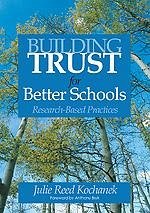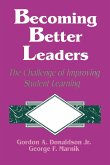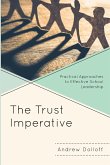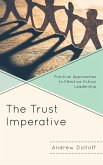- Broschiertes Buch
- Merkliste
- Auf die Merkliste
- Bewerten Bewerten
- Teilen
- Produkt teilen
- Produkterinnerung
- Produkterinnerung
Kochanek links the growth of trust with positive outcomes that benefit schools, such as increased participation, greater openness to innovations, boosts in parent outreach, and higher academic productivity.
Andere Kunden interessierten sich auch für
![Becoming Better Leaders Becoming Better Leaders]() Gordon A. DonaldsonBecoming Better Leaders31,99 €
Gordon A. DonaldsonBecoming Better Leaders31,99 €![The Trust Revolution in Schools The Trust Revolution in Schools]() Jeanie DaviesThe Trust Revolution in Schools187,99 €
Jeanie DaviesThe Trust Revolution in Schools187,99 €![The Trust Imperative The Trust Imperative]() Andrew DolloffThe Trust Imperative46,99 €
Andrew DolloffThe Trust Imperative46,99 €![The Trust Imperative The Trust Imperative]() Andrew DolloffThe Trust Imperative97,99 €
Andrew DolloffThe Trust Imperative97,99 €![Emotion Management and Feelings in Teaching and Educational Leadership Emotion Management and Feelings in Teaching and Educational Leadership]() Emotion Management and Feelings in Teaching and Educational Leadership119,99 €
Emotion Management and Feelings in Teaching and Educational Leadership119,99 €![Be Slacker Better Be Slacker Better]() Steve ZonnevylleBe Slacker Better31,99 €
Steve ZonnevylleBe Slacker Better31,99 €![Focus on Better Focus on Better]() Andre A. van LunFocus on Better23,99 €
Andre A. van LunFocus on Better23,99 €-
-
-
Kochanek links the growth of trust with positive outcomes that benefit schools, such as increased participation, greater openness to innovations, boosts in parent outreach, and higher academic productivity.
Hinweis: Dieser Artikel kann nur an eine deutsche Lieferadresse ausgeliefert werden.
Hinweis: Dieser Artikel kann nur an eine deutsche Lieferadresse ausgeliefert werden.
Produktdetails
- Produktdetails
- Verlag: Corwin
- Seitenzahl: 144
- Erscheinungstermin: 13. April 2005
- Englisch
- Abmessung: 254mm x 178mm x 8mm
- Gewicht: 286g
- ISBN-13: 9781412915144
- ISBN-10: 1412915147
- Artikelnr.: 21394910
- Herstellerkennzeichnung
- Libri GmbH
- Europaallee 1
- 36244 Bad Hersfeld
- gpsr@libri.de
- Verlag: Corwin
- Seitenzahl: 144
- Erscheinungstermin: 13. April 2005
- Englisch
- Abmessung: 254mm x 178mm x 8mm
- Gewicht: 286g
- ISBN-13: 9781412915144
- ISBN-10: 1412915147
- Artikelnr.: 21394910
- Herstellerkennzeichnung
- Libri GmbH
- Europaallee 1
- 36244 Bad Hersfeld
- gpsr@libri.de
Julie Reed Kochanek received her Ph.D from the University of Chicago in 2003. She is currently an assistant professor of sociology at Southern Oregon University in Ashland, Oregon.
Foreword - Anthony S. Bryk
Preface
Acknowledgments
About the Author
1. Introduction: Making a Case for Trust
Why Is Trust in Schools So Important?
Efficient Schools as Network Organizations
How Is Trust Defined in Schools?
What Do We Know About Building Trust?
Summary
2. Trust Building as a Developmental Process
Setting the Stage for Positive Interactions
Fostering Low-Risk Exchanges
Creating Opportunities for High-Risk Interactions
Illustrating a Model With Case Studies
3. MacNeil Elementary School: Improving a High-Trust School
The Principal in the Office
New Leadership: The People¿s Principal
Refining Relationships for Higher Levels of Trust
Summary
4. Mills Elementary School: Starting From a Lack of Trust
A School in Conflict
A Principal Under Siege
Developing Relationships From the Lowest Levels of Trust
Summary
5. Cole Magnet Elementary School: Coming Back to Trust
A Temporary Intrusion
Returning to Normal: The Maintenance Principal
Shared Governance, Facilitated Relationships, and a Lack of Direction
Summary
6. An Examination of Trust Building Through Quantitative Analyses
How Does a Low Base State of Trust Affect the Effectiveness of
Trust-Building Strategies?
In Schools With Growing Parent-Teacher Trust, How Does Parent Involvement
Vary With the Economic Level of the Parents?
How Important Is a Buffer Between Teachers and Parents in Schools Where
Parental Involvement Is Strong?
Does the Growth of Teacher-Principal Trust Lead to a Growth in
Teacher-Teacher Trust?
Summary
7. Implementing Trust-Building Strategies in Your School
Which Strategies Are Effective in Building Trust?
Conclusion
Resource A: CCSR Relational Trust Measures
Resource B: Measures of Key Concepts of Trust Building
References
Index
Preface
Acknowledgments
About the Author
1. Introduction: Making a Case for Trust
Why Is Trust in Schools So Important?
Efficient Schools as Network Organizations
How Is Trust Defined in Schools?
What Do We Know About Building Trust?
Summary
2. Trust Building as a Developmental Process
Setting the Stage for Positive Interactions
Fostering Low-Risk Exchanges
Creating Opportunities for High-Risk Interactions
Illustrating a Model With Case Studies
3. MacNeil Elementary School: Improving a High-Trust School
The Principal in the Office
New Leadership: The People¿s Principal
Refining Relationships for Higher Levels of Trust
Summary
4. Mills Elementary School: Starting From a Lack of Trust
A School in Conflict
A Principal Under Siege
Developing Relationships From the Lowest Levels of Trust
Summary
5. Cole Magnet Elementary School: Coming Back to Trust
A Temporary Intrusion
Returning to Normal: The Maintenance Principal
Shared Governance, Facilitated Relationships, and a Lack of Direction
Summary
6. An Examination of Trust Building Through Quantitative Analyses
How Does a Low Base State of Trust Affect the Effectiveness of
Trust-Building Strategies?
In Schools With Growing Parent-Teacher Trust, How Does Parent Involvement
Vary With the Economic Level of the Parents?
How Important Is a Buffer Between Teachers and Parents in Schools Where
Parental Involvement Is Strong?
Does the Growth of Teacher-Principal Trust Lead to a Growth in
Teacher-Teacher Trust?
Summary
7. Implementing Trust-Building Strategies in Your School
Which Strategies Are Effective in Building Trust?
Conclusion
Resource A: CCSR Relational Trust Measures
Resource B: Measures of Key Concepts of Trust Building
References
Index
Foreword - Anthony S. Bryk
Preface
Acknowledgments
About the Author
1. Introduction: Making a Case for Trust
Why Is Trust in Schools So Important?
Efficient Schools as Network Organizations
How Is Trust Defined in Schools?
What Do We Know About Building Trust?
Summary
2. Trust Building as a Developmental Process
Setting the Stage for Positive Interactions
Fostering Low-Risk Exchanges
Creating Opportunities for High-Risk Interactions
Illustrating a Model With Case Studies
3. MacNeil Elementary School: Improving a High-Trust School
The Principal in the Office
New Leadership: The People¿s Principal
Refining Relationships for Higher Levels of Trust
Summary
4. Mills Elementary School: Starting From a Lack of Trust
A School in Conflict
A Principal Under Siege
Developing Relationships From the Lowest Levels of Trust
Summary
5. Cole Magnet Elementary School: Coming Back to Trust
A Temporary Intrusion
Returning to Normal: The Maintenance Principal
Shared Governance, Facilitated Relationships, and a Lack of Direction
Summary
6. An Examination of Trust Building Through Quantitative Analyses
How Does a Low Base State of Trust Affect the Effectiveness of
Trust-Building Strategies?
In Schools With Growing Parent-Teacher Trust, How Does Parent Involvement
Vary With the Economic Level of the Parents?
How Important Is a Buffer Between Teachers and Parents in Schools Where
Parental Involvement Is Strong?
Does the Growth of Teacher-Principal Trust Lead to a Growth in
Teacher-Teacher Trust?
Summary
7. Implementing Trust-Building Strategies in Your School
Which Strategies Are Effective in Building Trust?
Conclusion
Resource A: CCSR Relational Trust Measures
Resource B: Measures of Key Concepts of Trust Building
References
Index
Preface
Acknowledgments
About the Author
1. Introduction: Making a Case for Trust
Why Is Trust in Schools So Important?
Efficient Schools as Network Organizations
How Is Trust Defined in Schools?
What Do We Know About Building Trust?
Summary
2. Trust Building as a Developmental Process
Setting the Stage for Positive Interactions
Fostering Low-Risk Exchanges
Creating Opportunities for High-Risk Interactions
Illustrating a Model With Case Studies
3. MacNeil Elementary School: Improving a High-Trust School
The Principal in the Office
New Leadership: The People¿s Principal
Refining Relationships for Higher Levels of Trust
Summary
4. Mills Elementary School: Starting From a Lack of Trust
A School in Conflict
A Principal Under Siege
Developing Relationships From the Lowest Levels of Trust
Summary
5. Cole Magnet Elementary School: Coming Back to Trust
A Temporary Intrusion
Returning to Normal: The Maintenance Principal
Shared Governance, Facilitated Relationships, and a Lack of Direction
Summary
6. An Examination of Trust Building Through Quantitative Analyses
How Does a Low Base State of Trust Affect the Effectiveness of
Trust-Building Strategies?
In Schools With Growing Parent-Teacher Trust, How Does Parent Involvement
Vary With the Economic Level of the Parents?
How Important Is a Buffer Between Teachers and Parents in Schools Where
Parental Involvement Is Strong?
Does the Growth of Teacher-Principal Trust Lead to a Growth in
Teacher-Teacher Trust?
Summary
7. Implementing Trust-Building Strategies in Your School
Which Strategies Are Effective in Building Trust?
Conclusion
Resource A: CCSR Relational Trust Measures
Resource B: Measures of Key Concepts of Trust Building
References
Index








